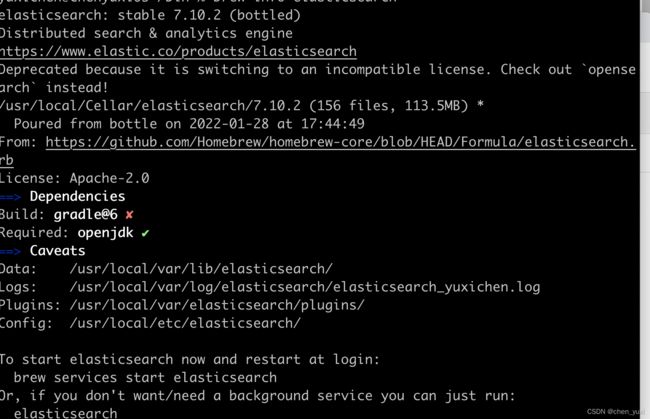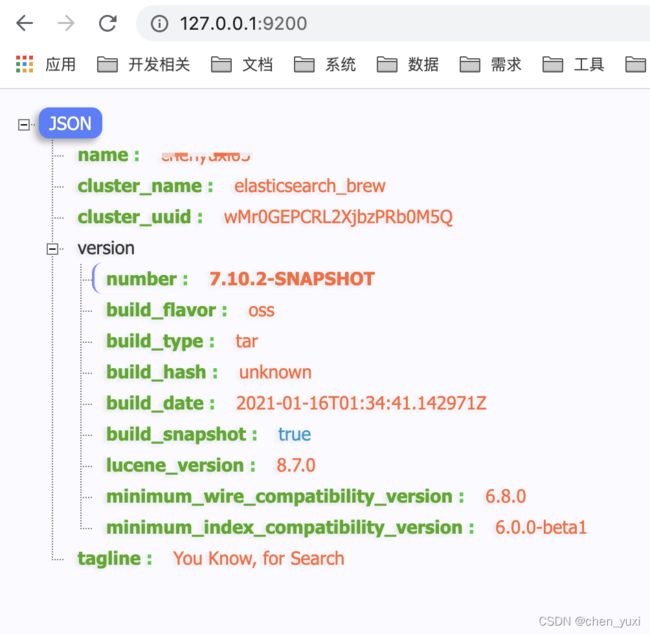elasticsearch(es)的安装-macOs
前提:已经安装过jdk1.8
java -version #查看jdk版本
1.es的安装和访问
es安装
brew install elasticsearch #安装
brew info elasticsearch # 查看es信息
brew services start elasticsearch # 启动
2.kibana的安装和访问
kibana可以通过可视化的界面操作访问es
- kibana安装
brew install kibana #安装
brew info kibana # 查看信息
brew services start kibana #启动
3.es集群搭建
之前是通过brew命令安装的es,虽然一键很爽,但是要搭建集群,按照下述文章搭建单机版es集群的说法,需要找到安装包
## 查看全部安装路径
brew list
## 查看指定软件安装路径
brew list 软件名
实战
brew list elasticsearch
## 结果
/usr/local/Cellar/elasticsearch/7.10.2/.bottle/etc/ (3 files)
/usr/local/Cellar/elasticsearch/7.10.2/bin/elasticsearch
/usr/local/Cellar/elasticsearch/7.10.2/bin/elasticsearch-keystore
/usr/local/Cellar/elasticsearch/7.10.2/bin/elasticsearch-plugin
/usr/local/Cellar/elasticsearch/7.10.2/bin/elasticsearch-shard
/usr/local/Cellar/elasticsearch/7.10.2/homebrew.mxcl.elasticsearch.plist
/usr/local/Cellar/elasticsearch/7.10.2/libexec/bin/ (8 files)
/usr/local/Cellar/elasticsearch/7.10.2/libexec/lib/ (42 files)
/usr/local/Cellar/elasticsearch/7.10.2/libexec/modules/ (93 files)
查看通过安装包安装es的文章安装包安装es-mac,可以看到,/usr/local/Cellar/elasticsearch/7.10.2/ 其实就是安装包,试着复制,然后安装。
cp -R 7.10.2 7.10.2.backup1
cp -R 7.10.2 7.10.2.backup2
得到两个安装包的副本后,修改副本中的配置文件
但是进文件夹里看,并没有config文件夹,通过brew命令查看es安装情况,可以得到config路径:/usr/local/etc/elasticsearch/
和我假设的不一致。/usr/local/Cellar/elasticsearch/7.10.2/ 并不是安装包,只是通过brew命令后的安装路径。
brew info elasticsearch
## 结果
From:https://github.com/Homebrew/homebrew-core/blob/HEAD/Formula/elasticsearch.rb
Config: /usr/local/etc/elasticsearch/
通过brew命令还可以得到安装包路径:https://github.com/Homebrew/homebrew-core/blob/HEAD/Formula/elasticsearch.rb 点进去后得到rul:https://github.com/elastic/elasticsearch/archive/v7.10.2.tar.gz。点击下载、解压后目录如下,也没有config目录。
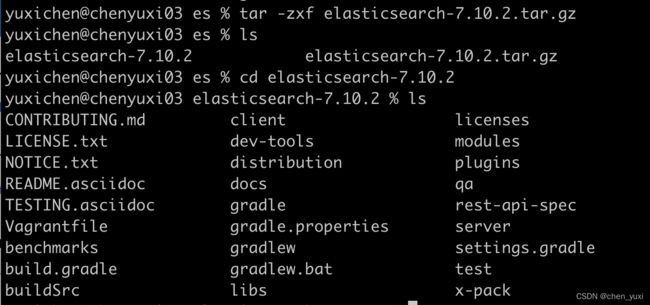
考虑从官网下载:https://www.elastic.co/cn/start ,此时有config目录了

检查已有es的config文件里的cluster name。将两者修改成一致。cyx_elasticsearch
## 通过brew安装的es的yml文件,路径:/usr/local/etc/elasticsearch/
cluster.name: elasticsearch_brew
## 通过官网下载的es里的yml文件,路径:~/software/es/es-a/elasticsearch-8.0.1/config
cluster.name: my-application
elasticsearch.yml文件的解释&修改
# ======================== Elasticsearch Configuration =========================
#
# NOTE: Elasticsearch comes with reasonable defaults for most settings.
# Before you set out to tweak and tune the configuration, make sure you
# understand what are you trying to accomplish and the consequences.
#
# The primary way of configuring a node is via this file. This template lists
# the most important settings you may want to configure for a production cluster.
#
# Please consult the documentation for further information on configuration options:
# https://www.elastic.co/guide/en/elasticsearch/reference/index.html
#
# ---------------------------------- Cluster -----------------------------------
#
# Use a descriptive name for your cluster:
#
cluster.name: cyx-application
#
# ------------------------------------ Node ------------------------------------
#
# Use a descriptive name for the node:
#
node.name: node-1
# 是否有资格选举为主节点
node.master: true
# 是否存储数据
node.data: true
# 最大集群节点数
node.max_local_storage_nodes: 3
#
# Add custom attributes to the node:
#
#node.attr.rack: r1
#
# ----------------------------------- Paths ------------------------------------
#
# Path to directory where to store the data (separate multiple locations by comma):
#
path.data: /Users/yuxichen/software/es/es-a/data
#
# Path to log files:
#
path.logs: /Users/yuxichen/software/es/es-a/logs
#
# ----------------------------------- Memory -----------------------------------
#
# Lock the memory on startup:
#
#bootstrap.memory_lock: true
#
# Make sure that the heap size is set to about half the memory available
# on the system and that the owner of the process is allowed to use this
# limit.
#
# Elasticsearch performs poorly when the system is swapping the memory.
#
# ---------------------------------- Network -----------------------------------
#
# By default Elasticsearch is only accessible on localhost. Set a different
# address here to expose this node on the network:
#
#network.host: 192.168.0.1
#
# By default Elasticsearch listens for HTTP traffic on the first free port it
# finds starting at 9200. Set a specific HTTP port here:
# 端口号
http.port: 9201
# 内部节点之间沟通端口
transport.tcp.port: 9500
#
# For more information, consult the network module documentation.
#
# --------------------------------- Discovery ----------------------------------
#
# Pass an initial list of hosts to perform discovery when this node is started:
# The default list of hosts is ["127.0.0.1", "[::1]"]
# 候选主节点地址
#
discovery.seed_hosts: ["127.0.0.1:9300", "127.0.0.1:9400"]
#
# Bootstrap the cluster using an initial set of master-eligible nodes:
#
cluster.initial_master_nodes: ["node-1", "node-2"]
#
# For more information, consult the discovery and cluster formation module documentation.
#
# ---------------------------------- Various -----------------------------------
#
# Allow wildcard deletion of indices:
#
#action.destructive_requires_name: false
总结下,yml文件需要修改的配置
cluster.name: cyx-application
node.name: node-1
node.master: true
node.data: true
node.max_local_storage_nodes: 3
path.data: /Users/yuxichen/software/es/es-a/data
path.logs: /Users/yuxichen/software/es/es-a/logs
http.port: 9201
transport.tcp.port: 9500
discovery.seed_hosts: ["127.0.0.1:9200", "127.0.0.1:9201"]
cluster.initial_master_nodes: ["node-1", "node-2"]
配置完三个节点的yml后,开始关闭已经启动的es
brew services stop elasticsearch
#输出
Stopping `elasticsearch`... (might take a while)
==> Successfully stopped `elasticsearch` (label: homebrew.mxcl.elasticsearch)
试着启动三个节点
#通过brew安装的
brew services start elasticsearch
#输出
==> Successfully started `elasticsearch` (label: homebrew.mxcl.elasticsearch)
#通过下载的安装包启动
./bin/elasticsearch
##输出
报错一:node.master设置找不到
报错二:transport.tcp.port: 设置找不到
把这些都删除后,直接在浏览器中输入localhost:9201,提示需要用户名密码,但是我又没设置过,在官网文档elasticsearch8.0.1
和网上的文档也没有找到第一次登陆需要用户名密码的原因。就在配置文件中设置了不需要鉴权
可以启动的官网下载的elasticsearch8.0.1版本的yml文件修改如下
cluster.name: cyx-application
node.name: node-1
path.data: /Users/yuxichen/software/es/es-a/data
path.logs: /Users/yuxichen/software/es/es-a/logs
http.port: 9201
cluster.initial_master_nodes: ["node-1", "node-2"]
xpack.security.enabled: false
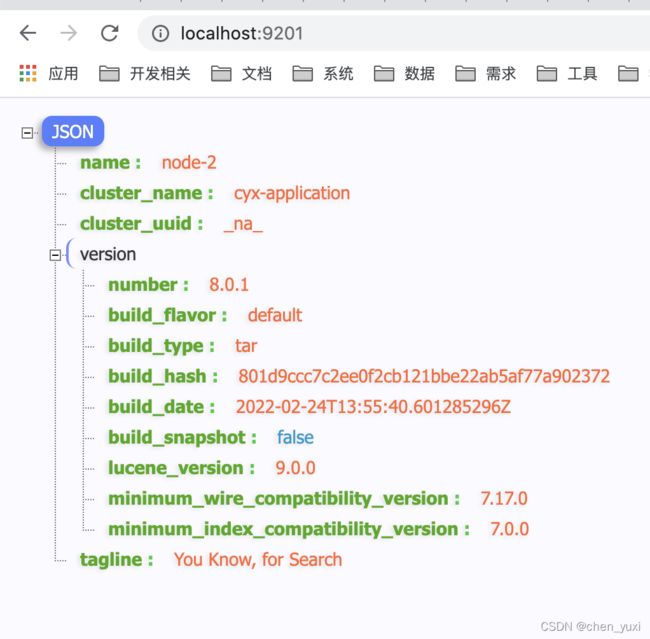
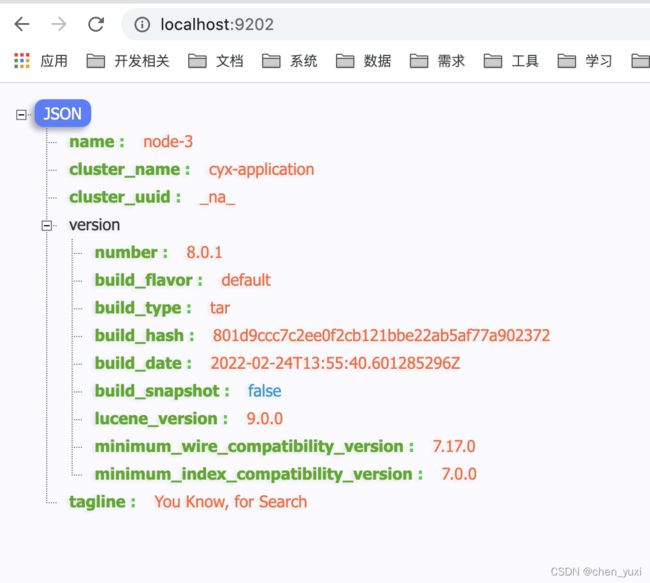
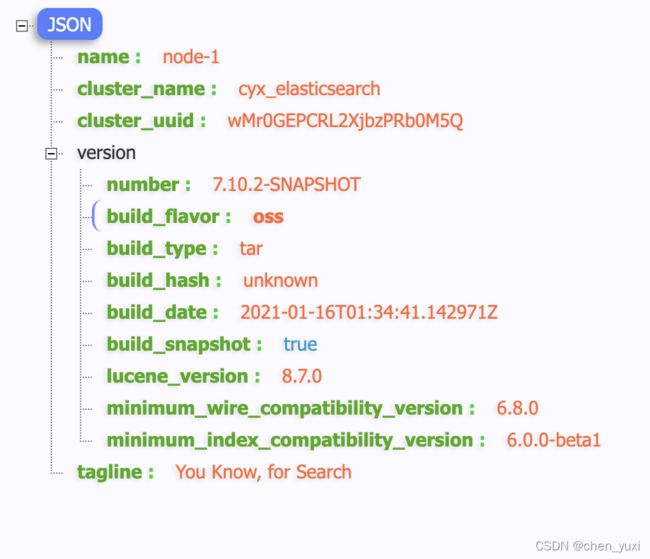
接下来测试集群是否搭建成功&配置kibana
测试集群,输出结果如下,可以看出节点总数为1,所以集群没有搭建成功,需要找下原因
http://localhost:9200/_cat/health?v

实在是找不到原因,只好放弃8.0.1这个版本太新了,下载了稍微老一点的版本:7.16.0,按照常见文章的配置,看上去是成功了

配置了下kibana,然后查看集群健康,发现竟然是red,我要哭了

整了半天还是一直是yellow,且node-2、3启动时候报错,搞不定了,先去洗漱睡了好困啊啊啊啊
[2022-03-04T00:24:07,468][ERROR][o.e.i.g.DatabaseNodeService] [node-3] failed to download database [GeoLite2-City.mmdb]
org.elasticsearch.cluster.block.ClusterBlockException: blocked by: [SERVICE_UNAVAILABLE/1/state not recovered / initialized];
at org.elasticsearch.cluster.block.ClusterBlocks.globalBlockedException(ClusterBlocks.java:179) ~[elasticsearch-7.16.0.jar:7.16.0]
at org.elasticsearch.cluster.block.ClusterBlocks.globalBlockedRaiseException(ClusterBlocks.java:165) ~[elasticsearch-7.16.0.jar:7.16.0]
at org.elasticsearch.action.search.TransportSearchAction.executeSearch(TransportSearchAction.java:927) ~[elasticsearch-7.16.0.jar:7.16.0]
at org.elasticsearch.action.search.TransportSearchAction.executeLocalSearch(TransportSearchAction.java:761) ~[elasticsearch-7.16.0.jar:7.16.0]
at org.elasticsearch.action.search.TransportSearchAction.lambda$executeRequest$6(TransportSearchAction.java:397) ~[elasticsearch-7.16.0.jar:7.16.0]
at org.elasticsearch.action.ActionListener$1.onResponse(ActionListener.java:136) ~[elasticsearch-7.16.0.jar:7.16.0]
at org.elasticsearch.index.query.Rewriteable.rewriteAndFetch(Rewriteable.java:112) ~[elasticsearch-7.16.0.jar:7.16.0]
at org.elasticsearch.index.query.Rewriteable.rewriteAndFetch(Rewriteable.java:77) ~[elasticsearch-7.16.0.jar:7.16.0]
参考:https://www.cnblogs.com/chenyanbin/p/13493920.html
参考:
Mac安装es

